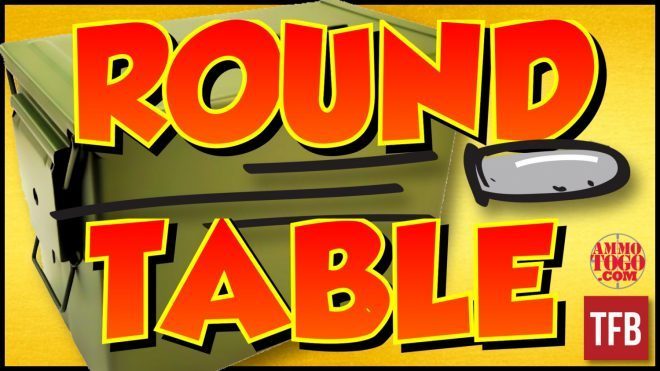Welcome back to another edition of TFB’s Round Table sponsored by Ammunition To Go! For those who are first joining us, this is a multi-part series where TFB will discuss the characteristics of great ammunition for specific applications. This could vary from big game hunting, plinking, precision rifle matches, small game hunting, or even pistol competitions. Chances are there is someone here at TFB who can offer you advice on buying the right round for your task at hand. This week I will offer up some tips on picking the BEST 9mm Practice Ammunition.
TFB Round Table: Picking the BEST 9mm Practice Ammunition
The 9mm cartridge in the past decade has become the hands-down favorite for shooting enthusiasts when it comes to defensive carry, competition, and just general recreation. It has climbed to the top for good reasons, too. It is offered in a plethora of makes and models, it has decent Ft-Lbs of energy, and it is fairly affordable to shoot. When people are looking for the BEST 9mm Practice Ammunition that conversation normally begins with price. I will never argue against shooting cheap ammo (who does not like cheap ammo?), but there are some more considerations you should account for as well. We will cover all of those here to help you make the most informed ammunition purchase decision possible!
Casings – What are We Rubbing Up Against?
With the mindset of you should buy the cheapest ammo you possibly can, you will undoubtedly run into a gamut of different casings your 9mm could be launching from. While cheap ammo, or even free ammunition, is my favorite kind, you still need to account for how it is going to affect your firearm. The main types you will likely encounter are:
- Brass
- Nickel
- Steel
- Bi-Metal (unknown mixture)
If the firearm you own is junky or you are running it ‘til the wheels fall off, then all of the above casings are fair game. If you are of the ilk that likes cheap ammo, but you want to take care of your gun, then we will assess each casing type. Brass is the most common casing type and is perfect for nearly everybody and every firearm. The reason why is brass is a soft metal; softer than what the barrel of your firearm is made of. So when push comes to shove the casing will get damaged before your barrel or firearm ever does. Being that brass is soft, it is also malleable enough to be reloaded.
Nickel is similar in that it is a metal that is softer than your barrel, but it is more rigid and stiff than brass. Soft and malleable enough to be reloaded, but stronger than brass where it will not wear as much after repeated extractions and chamberings. This is why you see a lot of defense hollow-points (HP) use nickel casings. If people extract and re-chamber the same round over and over on a daily basis nickel is better-suited to withstand that type of abuse and wear.
Steel and bi-metal mixtures fall into the same category of not being ideal for many firearms but can work just fine. The reason why they are not entirely ideal is most firearm barrels are made of steel, and two like metals rubbing on each other can create erosion and undesirable wear. I am sure you have anecdotally heard from friends who dump thousands of steel casing rounds through their firearms with no adverse side affects, but there is the potential for wear. Something to simply keep in mind. Your safest bet is always to use brass for the BEST 9mm Practice Ammunition. It is still relatively affordable and more gentle on your gun.
Bullets – What Freedom Seeds are you Launching?
When it comes to the BEST 9mm Practice Ammunition, a facet of that equation we need to address is the bullet. The reason why is we need to understand what will occur when the bullet hits your target. Most of us shoot full-metal jacket (FMJ) ammo which is completely fine for paper targets or even steel at greater distances. In regards to paper targets, it will just pencil through and hit the berm on the back side. With steel targets, you have the potential for lead or jacket splatter upon impact. If you are shooting greater distances, like 20 yards or more, you are likely safe if you are wearing safety glasses and hearing protection.
Another option is frangible bullets for practice ammunition. If you are in love with the PING of shooting steel targets and like running and gunning at close quarters, frangibles will fall apart or essentially disintegrate upon impact keeping you, the shooter, safe. Frangible ammo does typically cost more, but the buzzword of “best” can come in many forms for many people. If you love shooting steel (sometimes in close proximity) then frangible ammo may be for you.
A final bullet type you might want to practice with is a hollow-point (HP). Most of us are not doing mag dumps of HP because it is admittedly expensive, but you might want to shoot a few mags from time-to-time to ensure your carry ammo patterns the same as your practice ammo. All in all, FMJ and frangible ammo are your go-to flavors for the BEST 9mm Practice Ammunition, but it always depends on what you are exactly practicing.
Velocity – Do you want to Nudge your Target or Roll it into Next week?
Something that is an after-thought for most of us when it comes to buying 9mm ammo is the velocity. To oversimplify this characteristic of your ammo, you are basically dealing with subsonic ammunition (1,125 FPS or less) or supersonic ammo (1,125 FPS or greater). With supersonic ammo, you are going to shoot flatter for greater distances, but the converse effect is slightly more recoil. Most of us will not whine about the recoil of 9mm like it is unbearable, but if you are shooting for speed, the more recoil you experience means more precious seconds you are spending bringing your muzzle back down to engage your next target.
With subsonic ammo, your bullet is going to begin dropping sooner, but you also get less recoil, less muzzle rise, opportunity to shoot faster, and less noise. Also, sub-sonic ammo pairs beautifully for all of us who happen to own silencers. If you are shooting paper targets, steel, or simply blazing away for fun then FMJ is typically your bread ‘n butter ammunition, but subsonic has a good argument for its use as well.
WRAP UP – BEST 9mm practice AMMUNITION
When you are picking out 9mm practice ammunition you have a lot of options if you scrutinize long enough about it. You have options from subsonic to nickel casings to frangibles. Overall, try not to overthink it. Simply, get out shooting, have fun, be safe, and hopefully, it is light on your wallet. Some of the cliff notes for choosing the best 9mm practice ammunition are as follows:
- Casings – Brass is typically your best bet, but you can always spend less (or more) if the occasion or application calls for it.
- Bullets – FMJ is predominantly what you will run into, but if you are shooting steel targets really close, look into using some frangibles.
- Velocity – Most cheap ammo is going to be supersonic (~1,200 FPS), but sometimes paying extra for slower velocities can have a lot of upsides.
As always, thank you for reading TFB! Be safe out there, have fun while shooting, and we will see you next time for TFB’s Round Table brought to you by Ammunition to Go! Also, let us know what you think in the Comments below! We always appreciate your feedback.
TFB’S ROUND TABLE IS BROUGHT TO YOU BY AMMOTOGO.COM
Federal LE Ballisticlean 9mm 100 Grain RHT Frangible
https://www.ammunitiontogo.com/product_info.php/pName/50rds-9mm-federal-le-ballisticlean-100gr-rht-frangible

This 9mm Luger (9×19 Parabellum) BallistiClean ammunition is manufactured by Federal Premium, one of the most respected companies in the shooting industry. Each round is loaded with a 100 grain RHT frangible projectile made from compressed copper powder. Leaving the muzzle at a velocity of 1240 feet per second with 341 foot pounds of energy, RHT bullets break-up immediately on contact with metal targets. This significantly reduces the risk of ricochet or backsplash while also preserving metal targets.
All BallistiClean loads feature a copper-plated primer and reloadable brass case. Each factory fresh cartridge features a “NT” (non-toxic) head stamp to clearly identify them as training rounds. This eliminates the dangerous possibility of confusing them with duty or self-defense ammo. This ammunition is packed in 50-round boxes.
Sellier & Bellot 9mm 100 Grain Frangible RHFP Ammo
https://www.ammunitiontogo.com/product_info.php/pName/50rds-9mm-sellier-bellot-100gr-frangible-ammo
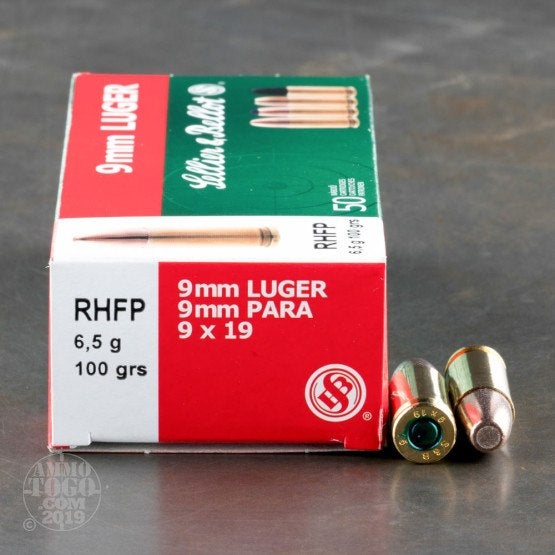
This 9mm Luger ammo is made for shooters who yearn for a reasonably priced frangible round. Sellier & Bellot includes this caliber in their Law Enforcement line of ammunition, and it features a 100 grain reduced hazard flat point (RHFP) bullet with a frangible lead core. The compressed lead core of the frangible projectile breaks apart upon when hitting your steel targets reducing the chance of ricochet making this a great choice for close range training with steel targets.
Sellier & Bellot field tests their ammunition to ensure the highest quality standards are achieved by each round that leaves their factory in the Czech Republic. This ammo is loaded into new production brass casings that are Boxer-primed and reloadable. Order your 50 round box of this 9mm ammo today!
Federal Syntech 9mm 150 Grain Total Synthetic Jacket Ammo
https://www.ammunitiontogo.com/product_info.php/pName/50rds-9mm-federal-syntech-150gr-total-synthetic-jacket-ammo
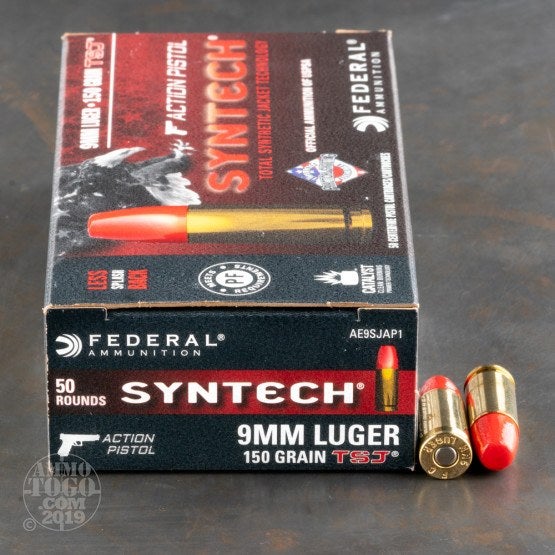
Good pistols are expensive, which is why we clean them and keep them in locked safes. If you’d like to keep your 9mm healthy for as long as possible, consider firing Federal’s Syntech line of ammunition through it as often as you can. This cartridge features a 150 grain total synthetic jacket projectile, which eliminates metal-on-metal contact in your bore to protect its rifling and extend its lifespan. It also prevents bore fouling, so you can enjoy laser-accurate shots for far longer in between cleanings.
This round’s bullet’s flat nose is ideal for shooting steel targets, as its greater surface area will transfer more energy to them upon impact. The nature of its synthetic jacket means you’ll enjoy far less splash-back as well. This round further offers a clean burning propellant that will treat your action nicely, and reduced felt recoil that will treat your wrists just as nicely, too. Whether you’re competing or serious about your training, or just want to show your pistol that you care about it, these rounds are the perfect fix.
Winchester Service Grade 9mm 115 Grain FMJ Ammo
https://www.ammunitiontogo.com/product_info.php/pName/500rds-9mm-winchester-service-grade-115gr-fmj-ammo
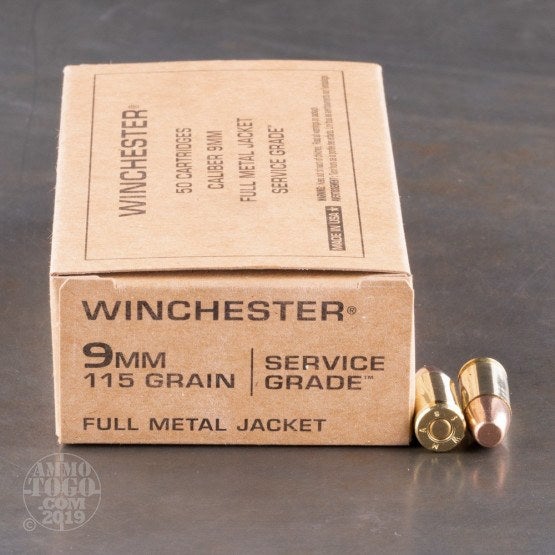
This 9mm Winchester Service Grade ammo is range ammo at its finest. Winchester manufactures these cartridges for the US Army MHS Progam, so you can count on their quality and consistency. Each round in this 500 round case has a 115gr full metal jacket projectile that is crimped into a new brass casing. For those of you who enjoy the value-add of reloadable casings, these Boxer-primed brass casings are reusable as well as non-corrosive. If you want to get the most out of your range time, order these service grade 9mm cartridges by Winchester today.
Fiocchi 9mm 158 Grain Sub-Sonic FMJ Ammo
https://www.ammunitiontogo.com/product_info.php/pName/50rds-9mm-fiocchi-158gr-sub-sonic-fmj-ammo
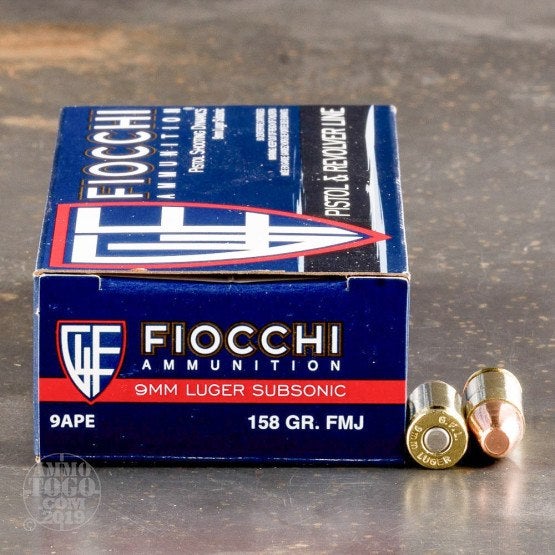
This is Fiocchi 9mm 158gr. Sub-Sonic Full Metal Jacket Ammo. This ammo is manufactured by Fiocchi in Italy, and is excellent quality ammo. This ammo travels at 940 FPS which is well below super-sonic. I have shot many rounds of this ammo and I am very pleased with the way it functions. It is clean and accurate. This ammo is brass cased, boxer primed, non-corrosive and 100% new factory ammo. This is some excellent sub-sonic ammo for the price. This ammo comes packed in 50rd. boxes.
 Your Privacy Choices
Your Privacy Choices
